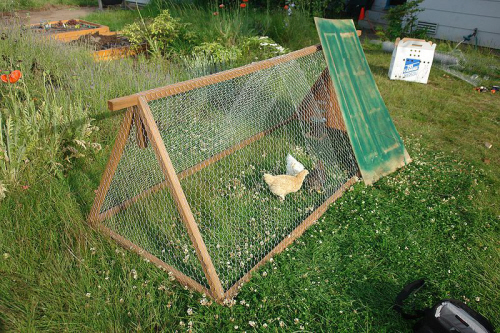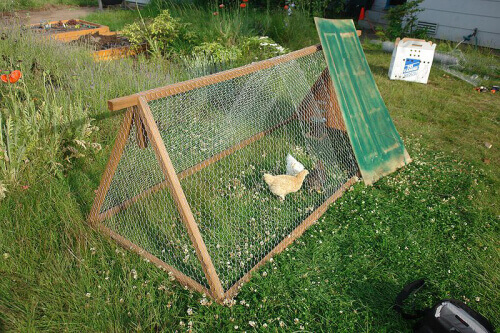
I’ve got that admit that, for a long time, I misunderstood (or, at least, didn’t fully understand) the concept of permaculture. I thought of it as “something kind of like organic agriculture.” While growing food in a manner modeled on ecological relationships is a part of the idea, it is only a part: Santa Fe, New Mexico’s Permaculture Institute defines it as “an ecological design system for sustainability in all aspects of human endeavor. It teaches us how build natural homes, grow our own food, restore diminished landscapes and ecosystems, catch rainwater, build communities and much more.” So, I’ve seen permaculture in action… I didn’t identify it as such, though.
This kind of approach to living requires its own set of tools, and, much like my fascination with appropriate technology, I’ve gotten interested in the “technology” of permaculture. Yes, there is some relatively complex machinery being developed around the idea, but much of it is fairly simple… enough for the average do-it-yourself-er, or even someone with less skills than that.
One of those simple technologies, the chicken tractor, first drew my attention because, well, it’s an attention-catching name… but also because of its simplicity, and ability to serve a number of purposes elegantly.
So, What Is A Chicken Tractor?
In short, it’s a mobile chicken coop (told you it was simple). That may not strike you as a big deal, but a chicken tractor creates a solution for two issues of those who raise relatively small numbers of chickens:
- It allows you to keep your chickens diets varied while keeping them “close to home”: Regardless of the space in which you’re raising chickens, you’ll want to make sure their diet stays varied (for their health, and for the much better tasting eggs). A chicken tractor allows you to move the chickens’ home to different parts of your property so they’re getting different types of food from their scratching and pecking (whether they’re coming home to roost from free ranging, or spending most of their time in the coop).
- It allows you to spread chicken poop around without a shovel: Counting on your chickens for soil fertilization? The tractor helps you keep that poop moving around (and not too concentrated in any one space).
- It’s a lot cleaner: OK, I’m making this assumption, but since most of these chicken tractors use the ground as “floors,” that sure seems like it’d mean a lot less cleaning.
When I see simple, I start looking for DIY projects… and like the rocket stove, for instance, this one’s found a niche on the web. Here are a few of the better/cooler/more well-detailed plans I’ve found.
4 Plans for Building A Chicken Tractor
1. The Recycled Wooden Pallet Plan
Yep, you can use recycled pallets for just about anything, it seems. The video below walks you through the process; video host Lou Giseman has also put together a text and image version at Instructables.
2. The Wind-Resistant Chicken Tractor
The folks at Working Wings have detailed the development of their own model of chicken tractor, including changes they made in the second version to withstand the high winds that can blow across their homestead in South Dakota. As with the pallet plan above, much of this one makes use of reused and recycled materials.
2. The Chicken Tractor For Raised Garden Beds
Gardening in a small space? Want to take advantage of free chicken fertilization? This tractor plan from Garden Girl Patti Moreno is designed to work in tandem with raised gardening beds.
4. The Deluxe Model Chicken Tractor
This plan from Oklahoma’s Kerr Center for Sustainable Agriculture is designed to withstand wind and dogs, and provide for every need a chicken might have. As such, it’s bigger (don’t expect to move this by hand – they use a small tractor), and more expensive to build (they estimate they spent about $290).
And a Bonus
No actual plans here, but Katy Skiner of The City Chicken has created a great pictorial history of her own chicken tractors built over the years (which may provide some inspiration). Lots of clever reuse going on here: everything from a broken tent gazebo to a pair of rollerblades have gone into her experiments with housing for the brood.
Know of other plans for building one of these versatile, movable chicken coops (especially ones made from reused or recycled materials, or kind of unusual)? Share them with us…
Image credit: John Larios at Wikimedia Commons under a Creative Commons license









































Thanks for this, Jeff. Shared on FB for my chicken-keeping friends and chicken-keeping hopefuls.
Thanks so much, Kathryn! I start digging into these concepts, and then it hits me: “hey… there’s a post here!”
Jeff, this is great. just fueling my continued chicken envy . . . 😉
We do what we can, Meg! 😉
Those are good examples of chicken tractors. Though chicken tractors are a definite step up from the coop and run and in my opinion can be an important tool in the garden or homestead, chicken owners should also investigate the paddock shift system for raising chickens if they have the room.
I’ll take a look, Kevin… thanks so much!
I like all the different ideas of chicken tractors you have on this post. I designed my own and can see benefits to some of these different designs. Using pallet wood is a good idea. I have been “dumpster diving” for wood to build my next chicken tractor cheaper.
We’d love to see your design, Steve…